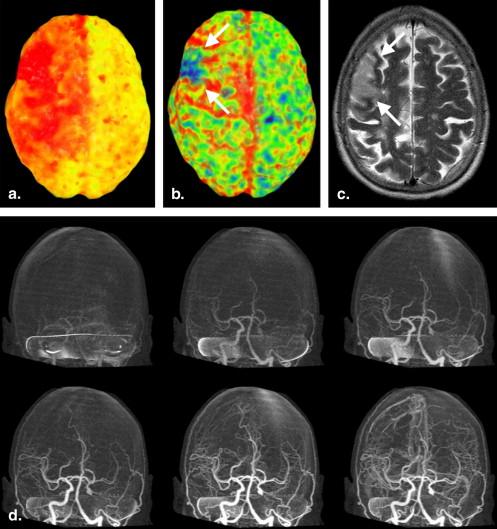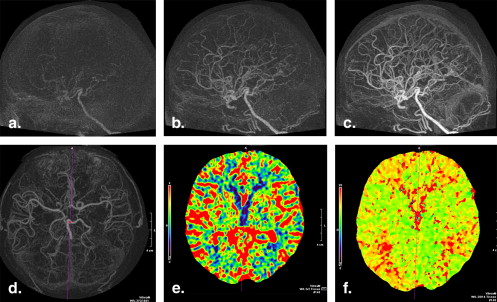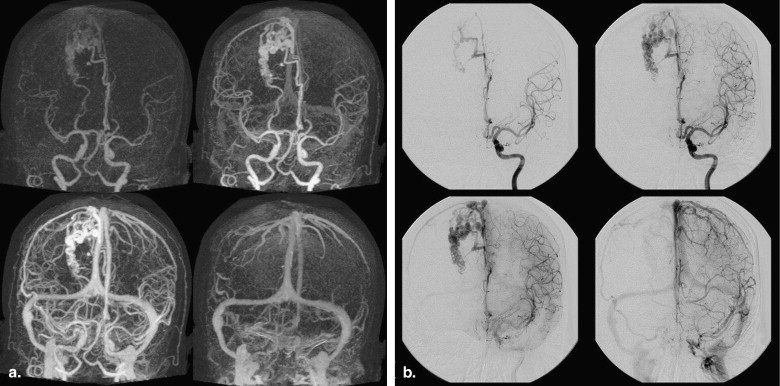Rationale and Objectives
The authors report study protocols and initial clinical experience in assessing patients with acute and chronic cerebrovascular disorders using the recently introduced technique of volume computed tomography (VCT).
Materials and Methods
Thirteen patients with presumptive cerebrovascular insufficiency underwent VCT using a 320-slice scanner (detector width, 160 mm), including time-resolved whole-brain perfusion and cerebral angiography (four-dimensional computed tomographic angiography [CTA] and computed tomographic perfusion [CTP]). Unenhanced cranial CT (cCT) and helical cervicocranial CT (three-dimensional CTA) were added according to clinical requirements. Study protocols are presented, and image quality, data management, and radiation exposure issues are discussed.
Results
In 12 of 13 patients, the procedure was performed successfully on admission; in the other patient, the study was aborted for clinical reasons and repeated. Total scan time amounted to about 5 minutes, and data reconstruction times were up to 10 minutes. About 9000 primary images were generated, partially in the enhanced Digital Imaging and Communications in Medicine format, thus requiring new data postprocessing and management strategies. Image artifacts restricted the use of single-rotation cCT and incremental VCT (three-dimensional CTA). Overall exposure figures (computed tomographic dose index and dose-length product) were increased by 65% on average when three-dimensional CTA was added to volume cCT and four-dimensional CTA and CTP (5.0 mSv and 2178 mGy · cm, respectively).
Conclusion
Preliminary clinical experience indicates that whole-brain four-dimensional CTA and CTP is a robust technique that provides relevant clinical information with respect to whole-brain perfusion as well as cerebral hemodynamics. The exposure benefit of deriving time-resolved perfusion and vessel images from one source data set is compromised when adding three-dimensional CTA to the protocol. Other acquisition techniques specific to VCT, such as single-rotation cCT and incremental three-dimensional CTA, suffer from restrictions in terms of image quality at present.
With the introduction of multislice technology into computed tomography (CT), the comprehensive, noninvasive assessment of the cervicocerebral vasculature using computed tomographic angiography (CTA) became possible ( ). Moreover, cerebral volume coverage could be extended up to 40 mm, thus enhancing cerebral perfusion imaging in patients with stroke ( ). Yet the disadvantage of incomplete brain volume coverage when using CT-based perfusion imaging as opposed to magnetic resonance imaging persisted and could not be fully compensated for by additional measures, such as the “toggling-table technique” ( ).
Until now, the recently introduced technique of volume CT (VCT) has been predominantly evaluated with respect to its suitability for cardiac imaging using 256-row and 320-row scanners ( ). Because of their detector widths of up to a 160 mm, scanners of this new generation can cover the whole brain in a single rotation, thus for the first time enabling CT-based whole-brain perfusion imaging.
Get Radiology Tree app to read full this article<
Get Radiology Tree app to read full this article<
Materials and methods
Patients
Get Radiology Tree app to read full this article<
Get Radiology Tree app to read full this article<
VCT
Get Radiology Tree app to read full this article<
Acquisition Protocols
Get Radiology Tree app to read full this article<
Table 1
Acquisition Protocols for 320-Slice Computed Tomography, Volume Mode and Standard Mode (Right Columns)
Parameter Volume cCT Four-Dimensional CTA and CTP Incremental cCT Helical Three-Dimensional CTA Tube voltage (kV) 120 80 120 120 Tube current (mA) 320 100 250 150 Rotation time (s) 1.0 1.0 1.0 0.5 Pitch — — — 0.61 Axial section thickness (mm) 0.5 0.5 4 and 8 0.5 Reconstruction interval (mm) 0.25 0.5 4 and 8 0.4
cCT, cranial computed tomography; CTA, computed tomographic angiography; CTP, computed tomographic perfusion.
Get Radiology Tree app to read full this article<
Get Radiology Tree app to read full this article<
Get Radiology Tree app to read full this article<
Get Radiology Tree app to read full this article<
Get Radiology Tree app to read full this article<
Get Radiology Tree app to read full this article<
Get Radiology Tree app to read full this article<
Data Management
Get Radiology Tree app to read full this article<
Get Radiology Tree app to read full this article<
Radiation Exposure
Get Radiology Tree app to read full this article<
Results
Patients
Get Radiology Tree app to read full this article<
Get Radiology Tree app to read full this article<
Get Radiology Tree app to read full this article<
Data Acquisition
Get Radiology Tree app to read full this article<
Get Radiology Tree app to read full this article<
Get Radiology Tree app to read full this article<
Postprocessing, Data Management, and Radiation Exposure
Get Radiology Tree app to read full this article<
Get Radiology Tree app to read full this article<
Get Radiology Tree app to read full this article<
Get Radiology Tree app to read full this article<
Table 2
Radiation Exposure Figures for Cranial 320-Slice Computed Tomography, Volume Mode and Standard Mode (Right Columns)
Parameter Volume cCT Four-Dimensional CTA and CTP Incremental cCT Helical Three-Dimensional CTA CTDI (mGy) 42.3 ± 4.6 98.7 ± 12.7 76.8 ± 16.8 36.7 ± 0.2 DLP (mGy · cm) 593.7 ± 16.4 1584.1 ± 201.2 1105.5 ± 217.9 1419.2 ± 139.6 Effective dose (mSv) 1.37 3.64 2.54 3.26
cCT, cranial computed tomography; CTA, computed tomographic angiography; CTDI, computed tomographic dose index; CTP, computed tomographic perfusion; DLP, dose-length product.
Get Radiology Tree app to read full this article<
Discussion
Get Radiology Tree app to read full this article<
Get Radiology Tree app to read full this article<
Get Radiology Tree app to read full this article<
Get Radiology Tree app to read full this article<
Get Radiology Tree app to read full this article<
Get Radiology Tree app to read full this article<
Get Radiology Tree app to read full this article<
Get Radiology Tree app to read full this article<
Get Radiology Tree app to read full this article<
Get Radiology Tree app to read full this article<
Get Radiology Tree app to read full this article<
Conclusion
Get Radiology Tree app to read full this article<
References
1. Klingebiel R., Busch M., Bohner G., et. al.: Multi-slice CT angiography in the evaluation of patients with acute cerebrovascular disease—a promising new diagnostic tool. J Neurol 2002; 249: pp. 43-49.
2. Youn S.W., Kim J.H., Weon Y.-C., et. al.: Perfusion CT of the brain using 40-mm-wide detector and toggling table technique for initial imaging of acute stroke. AJR Am J Roentgenol 2008; 191: pp. W120-W126.
3. Roberts H.C., Roberts T.P., Smith W.S., et. al.: Multisection dynamic CT perfusion for acute cerebral ischemia: the “toggling-table” technique. AJNR Am J Neuroradiol 2001; 22: pp. 1077-1080.
4. Klingebiel R., Kentenich M., Bauknecht H.C., et. al.: Comparative evaluation of 64-slice CT angiography and digital subtraction angiography in assessing the cervico-cranial vasculature. Vasc Health Risk Manage 2008; 4: pp. 901-907.
5. Dewey M., Zimmermann E., Laule M., Rutsch W., Hamm B.: Three-vessel coronary artery disease examined with 320-slice computed tomography coronary angiography. Eur Heart J 2008; 29: pp. 1669.
6. Wintermark M.: Brain perfusion-CT in acute stroke patients. Eur Radiol 2005; 15: pp. D28-D31.
7. Mori S., Obata T., Nakajima N., Ichihara N., Endo M.: Volumetric perfusion CT using prototype 256-detector row CT scanner: preliminary study with healthy porcine model. AJNR Am J Neuroradiol 2005; 26: pp. 2536-2541.
8. Cohnen M., Wittsack H.J., Assadi S., et. al.: Radiation exposure of patients in comprehensive computed tomography of the head in acute stroke. AJNR Am J Neuroradiol 2006; 27: pp. 1741-1745.
9. Mori S., Endo M., Nishizawa K., et. al.: Comparison of patient doses in 256-slice CT and 16-slice CT scanners. Br J Radiol 2006; 79: pp. 56-61.


